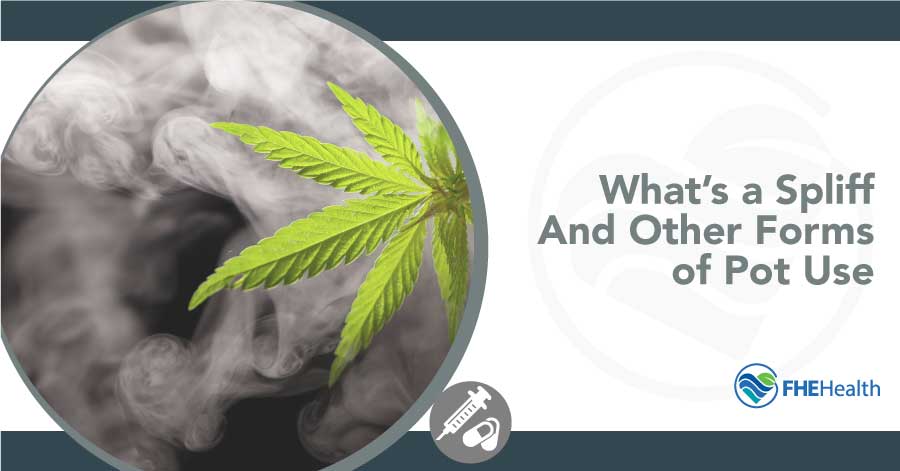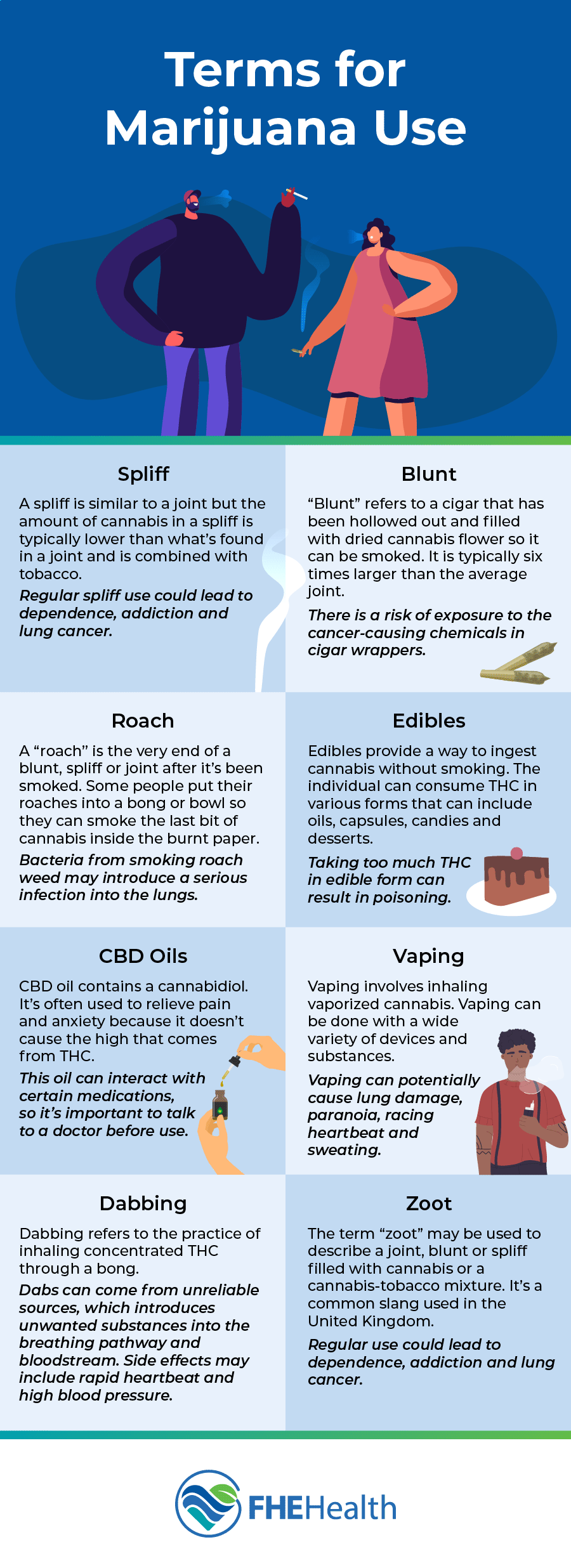
Since many states have legalized marijuana for medical and recreational use, the drug has steadily grown in popularity. An estimated 4.8 million people in the U.S. had marijuana use disorder in 2019, according to the 2019 National Survey on Drug Use and Health. Even so, advertisers and influencers continue to trumpet marijuana’s many uses and benefits, and pot shops, dispensaries, and grow houses are cropping up all over. Meanwhile, a whole vocabulary for the various forms of pot use has sprung up. Here, we’ll explore some of the more common slang terms for marijuana.
Terms for Marijuana Use
When it comes to common terms for marijuana and how marijuana is used, there is no shortage of slang and word choices today. Some terms are more prevalent in some parts of the United States or other countries. Similarly, terms that are popular today may fall from favor tomorrow—just as some terms that once were common no longer are.
 Spliff
Spliff
A spliff is a convenient way to smoke a combination of two habit-forming substances: marijuana and tobacco. Historians of cannabis often point to the West Indian origins of the term spliff, specifically mentioning Jamaica as the originating country. What native Jamaicans refer to as a spliff, though, is a product that only contains marijuana.
According to cannabis culture media, spliffs are more popular in countries outside of the United States. The term is more widely used in some European countries where cannabis users combine tobacco and the THC-laden ingredient, which gives them a buzz of energy. Users like to roll their spliffs because they can customize them to their preferences, controlling the mixture and ratio of tobacco and marijuana. There are also several paper choices to select from, ranging from plain, unflavored papers to distinctly fruity-flavored papers like watermelon, banana, honey, and green apple.
While a spliff is similar to a joint, which is a marijuana product rolled in white cigarette paper, the amount of cannabis in a joint is typically higher than what’s found in a spliff. According to some anecdotal accounts, there’s up to a gram of marijuana in a joint, whereas a spliff may contain only half that amount.
Health Concerns with Spliffs
Using spliffs is associated with a range of short- and long-term health risks. Not only do spliffs carry a cancer risk because they contain tobacco, a known carcinogen, but the marijuana they contain also increases the individual’s susceptibility to cancer. Cannabis smokers typically inhale more deeply and hold their breath longer than tobacco smokers. The result is a greater accumulation of carcinogenic ingredients in the respiratory tract. The long-term lung cancer risk of smoking one cannabis joint a day is equal to smoking about 20 tobacco cigarettes a day.
Despite the widely held belief that marijuana is safe to use, research has shown increased health risks for those who smoke the substance. One study noted that cannabis is a complex plant that has 400-plus chemical entities, 60 of which are cannabinoid compounds. Cannabis potency has been increasing worldwide, and several studies found some evidence of links between dose-related use of cannabis and an increased risk of developing a psychotic illness.
A small study published in the European Respiratory Journal found increased lung cancer risk among young adults using cannabis long-term. While researchers cautioned the results are conflicting and limited, they also noted that there may be a greater potential for lung cancer from smoking cannabis than tobacco. In cannabis cigarettes, there’s up to two times the concentration of carcinogenic polyaromatic hydrocarbons. Additionally, the tobacco in spliffs is packed less densely than in cigarettes, and users typically don’t use filters.
While a spliff is unlikely to create the kind of euphoria or high that a joint can produce, there is the possibility that regular spliff use could lead to dependence and addiction. This combination of tobacco and marijuana can become habit-forming and difficult to stop using. Additionally, tobacco contained in a spliff is a stimulant that can counter the mellowing aspect of the cannabis ingredient. While someone may think they’re not becoming dependent on the substances when they smoke spliffs, that may not always be the case.
Blunt
“Blunt” refers to a cigar that has been hollowed out and filled with dried cannabis flower so it can be smoked. Most people think the term “blunt” comes from the Phillies Blunt cigar brand. When it comes to joints versus blunts, blunts use the cigar, whereas joints use rolling paper to hold the cannabis in place.
Health Concerns with a Blunt
The amount of cannabis in a blunt is cause for concern. In general, the cigar used for blunt weed is six times larger than the average joint. The individual is also exposed to the cancer-causing chemicals in cigar wrappers or, in the case of joint rolling papers, chemicals that the individual will inhale when they burn. Additionally, cigar smoke contains more toxins than smoke from a joint, which is damaging to the lungs. The American Lung Association says that tobacco smoke and cannabis smoke share many of the same poisonous materials, harming the airways and lungs with each inhalation.
Roach
A “roach” is the very end of a blunt, spliff, or joint after it’s been smoked. Some people put their roaches into a bong or bowl so they can smoke the last bit of cannabis inside the burnt paper.
Health Concerns with Roaches
In addition to the toxins the individual may inhale from smoking marijuana, they also expose themself to bacteria by smoking roach weed and may introduce a serious infection into their lungs. Some research suggests that lighting cannabis a second time after it’s been exposed to flame can increase inhaled carcinogen levels, especially if the individual uses a butane lighter.
Edibles
Edibles provide a way to ingest cannabis without smoking. The individual can consume THC, the psychoactive chemical in marijuana, in various forms that can include oils, capsules, candies and desserts.
Health Concerns with Edibles
According to the Centers for Disease Control and Prevention, taking too much THC in edible form can result in poisoning. Kids and pets have an especially high risk of illness and hospitalization from accidentally ingesting cannabis. The body processes cannabis differently when the substance is eaten versus when it’s smoked, which can result in unexpected effects.
It’s easy to take too much THC when using edibles since it’s difficult to determine the exact dose. Because it takes 30 minutes to two hours for the effects to be noticeable, people often take too much when they don’t get the desired effect right away. The high lasts much longer with edibles than it does with smoked or vaped cannabis. The food the individual had eaten recently, their physical composition, and their THC tolerance also affect their experience with edibles.
CBD Oils
CBD oil contains cannabidiol, a chemical derived from cannabis. It’s often used to relieve pain and anxiety because it doesn’t cause the high that comes from THC. Different forms of CBD can be added to beverages, applied to the skin, or taken as capsules. Individuals can even use CBD as a spray that goes under the tongue.
Health Concerns with CBD Oil
CBD oil isn’t regulated, so the user can’t be sure about the purity of the product unless they purchase from a reputable source. This oil can interact with certain medications, including blood thinners, so it’s important to talk to a doctor before incorporating it into a daily wellness routine. The Mayo Clinic reports side effects that include fatigue, drowsiness, reduced appetite, diarrhea and dry mouth.
Vaping
Vaping involves inhaling vaporized cannabis. Proponents of the practice say it provides a pure experience with less lung damage than smoking. Vaping can be done with a wide variety of devices and substances, including cannabis, flower, oil, and wax-like forms.
Health Concerns with Vaping
Vaping can potentially cause lung damage because of exposure to vitamin E acetate, a common chemical additive in THC vape oils. The CDC even associates vaping nicotine and THC with e-cigarette product-associated lung injury, a life-threatening disease. Vaporizing cannabis also increases the risk of taking too much of the substance and experiencing unwanted effects like paranoia, racing heartbeat, and sweating.
Dabbing
Dabbing refers to the practice of inhaling concentrated THC through a bong, which may also be called a dab rig, outfitted for this purpose. The person places the cannabis concentrate on a quartz or metal device called an e-nail, which is heated with a specialized torch. While it’s similar to vaporizing concentrated cannabis in cartridge form, dabbing delivers a much higher dose of THC in the vapor. It’s also difficult to control intake.
Health Concerns with Dabbing
A 2017 study published in the medical journal Cureus associated dabbing with brain and heart-related toxicity, as well as potential psychosis. Dabs can come from unreliable sources, which introduces unwanted substances into the breathing pathway and bloodstream. They often contain solvents and other contaminants. Side effects may include rapid heartbeat and high blood pressure.
Other Slang for Marijuana
The term “zoot” may be used to describe a joint, blunt, or spliff filled with cannabis or a cannabis-tobacco mixture. It’s a common slang used in the United Kingdom. However, it tends to be a catch-all that can mean any type of smoked marijuana cigarette or cigar. “Jawn” is another common slang term in the cannabis lexicon. According to Urban Dictionary, the term comes from Philadelphia and typically refers to a blunt. However, in Philly, this term can also mean anything from a random person to a location to an object.
Seeking Help for Marijuana Use
While marijuana is legal to use in many states, using this drug isn’t always safe. Many people use the substance for managing mental and physical health conditions, paving the path to dependency. Fortunately, for those who are concerned about how frequently they or a loved one use marijuana, whether it is through spliffs or vapes, help is available. Contact us today to learn how we may be able to help and to begin the journey to a healthier, happier tomorrow.
FAQs About Spliffs, Blunts, and Modern Pot Use
Q: People use “spliff,” “joint,” and “blunt” interchangeably. Are they actually different things?
A: Yes, and the difference matters for your health. A joint is a standard marijuana cigarette wrapped in rolling paper. A spliff is a mix of tobacco and marijuana. A blunt is a cigar that’s been hollowed out and stuffed with weed. Because a blunt wrapper is made of tobacco leaf, it is significantly harsher on your lungs and delivers a massive dose of toxins compared to a standard paper joint, while a spliff shares some of this harshness due to the mix of marijuana and tobacco.
Q: I’ve heard weed is “natural” and safer than cigarettes. Is that really true?
A: “Natural” doesn’t mean safe. Cannabis smoke actually contains many of the same cancer-causing chemicals as tobacco smoke, often in higher concentrations. Because pot smokers tend to inhale deeply and hold their breath to get the full effect, they coat their lungs in more tar. Some research suggests the lung damage from smoking just one joint a day is equivalent to smoking a pack of 20 cigarettes. You are physically forcing carcinogenic ingredients to settle deep in your respiratory tract.
Q: I tried an edible and didn’t feel anything, so I ate another one. Two hours later, I was in a full panic. Why does that happen?
A: This is the classic “edible trap.” When you smoke, the THC hits your brain almost instantly. When you eat it, your body has to digest it first, which can take anywhere from 30 minutes to two hours. If you don’t feel the high immediately and decide to double your dose, you are stacking the effects. When it finally hits, it doesn’t come on gradually—it hits all at once. This can lead to “poisoning,” causing paranoia, racing heart rates, and hospitalizations, which are far more common with edibles than smoked weed.
Q: What exactly is “dabbing”? It looks more like a science experiment than smoking.
A: That’s a fair description. Dabbing involves heating a quartz or metal “nail” with a blowtorch to vaporize highly concentrated THC wax or oil. It isn’t just “strong weed”; it is a potent chemical extraction. Because you are inhaling such a massive dose of THC in a single breath, the risk of “greening out” (vomiting, fainting) or triggering a psychotic episode is much higher than with flower. Plus, street concentrates are often dirty, containing leftover solvents from the extraction process that you definitely don’t want in your lungs.
Q: Is vaping safer than smoking? I thought it was just water vapor.
A: It is definitely not just water vapor. Vaping marijuana oil has been linked to serious lung injuries, specifically E-cigarette or Vaping Use-Associated Lung Injury (EVALI). This is often caused by Vitamin E acetate, a thickening agent used in illicit vape cartridges. When heated and inhaled, it coats the lungs like grease, making it difficult to breathe. Just because there is no smoke doesn’t mean your lungs aren’t taking a beating.
Q: I save the ends of my joints (roaches) to smoke in a bowl later. Is that bad?
A: It’s messy and risky. The “roach” is the bottom of the barrel—it acts as a filter for everything you just smoked, so it is packed with concentrated tar and resin. Relighting burnt material releases even more carcinogens than fresh weed. On top of that, a soggy roach is a breeding ground for bacteria. Smoking it pushes those concentrated toxins and germs straight into your lungs.






